FHWA-HEP-17-050
Printer-friendly PDF →
FHWA Eco-Logical Case Studies Series
Example of Implementing Eco-Logical
Maine Department of Transportation
Atlantic Salmon Programmatic Consultation & In-lieu Fee Program
Agency: Maine Department of Transportation (MaineDOT)
Eco-Logical is an approach designed to help transportation, resource, and regulatory agencies integrate their infrastructure development and conservation planning processes and arrive at a joint set of environmental priorities. It organizes current methods to address natural resource identification, avoidance, minimization, and compensation into a systematic, nine-step process that starts at the beginning of the transportation planning process and concludes with establishing programmatic approaches to recurring natural resource issues that are implemented at the project level. This is one case study in a series that highlights how transportation agencies around the country are implementing the nine steps of Eco-Logical.
A follow-up to this case study, a Year One Snapshot, summarizes the cost and time savings realized in the first full year of the programmatic consultation in action.
A second follow-up to this case study, the Year Two Snapshot, reviews the second full year of implementation of the Atlantic salmon programmatic consultation, with a focus on the cost and time savings achieved since its enactment in 2017.
The Eco-Logical Approach
Eco-Logical’s nine steps organize how agencies can partner and integrate plans to identify environmental priority areas and ecological considerations in project planning and delivery. Agencies can apply the steps in order or independently of each other.
All steps are featured in this case study:
Step 1:
Build and strengthen collaborative partnerships and vision
Step 2:
Characterize resource status and integrate natural environment plans
Step 3:
Step 4:
Assess effects on conservation objectives
Step 5:
Establish and prioritize ecological actions
Step 6:
Develop crediting system
Step 7:
Develop programmatic consultation, biological opinion, or permit
Step 8:
Implement agreements, adaptive management and delivery projects
Step 9:
Update REF and plan
Summary
The FHWA and Maine Department of Transportation (MaineDOT) developed a programmatic Endangered Species Act (ESA) consultation and in-lieu fee program (ILF) for the federally listed endangered Atlantic salmon incorporating concepts from the Eco-Logical approach. This effort took 4 years to complete at an approximate cost of $276,000 ($250,000 in assistance from an FHWA Eco-logical Implementation Assistance grant).
Products
As part of its process, MaineDOT:
- Prioritized Atlantic salmon habitat recovery watersheds throughout the State based on conservation value and mitigation priority.
- Completed the Atlantic Salmon Programmatic Consultation with technical support from FHWA and in partnership with U.S. Fish and Wildlife Service (USFWS) for a range of transportation projects likely to result in unavoidable adverse effects to Atlantic salmon and their critical habitat.
- Is creating the Atlantic salmon-specific ILF program in partnership with the U.S. Army Corps of Engineers (USACE), which will allow public agencies, non-profit organizations, and private individuals to apply to use funds for restoration, enhancement and preservation projects.
- Developed and implemented monitoring protocols, including Turbidity, Post-Project, and Hydro-acoustic protocols, to increase the rigor of monitoring and reporting during construction.
Benefits
The programmatic consultation and ILF program are expected to improve project approval times by 60% and significantly improve conservation outcomes for the Gulf of Maine Atlantic salmon population.
Building Partnerships
The following partner agencies collaborated closely on the 4-year programmatic effort:
- Maine Department of Transportation
- Federal Highway Administration
- U.S. Army Corps of Engineers
- U.S. Fish and Wildlife Service
- Maine Turnpike Authority
MaineDOT’s Challenge
Due to the backlog of transportation projects awaiting completion of section 7 consultation in Maine, MaineDOT was buffering delivery timelines by at least a year on bridge and culvert projects. As a result, needed improvements to key transportation infrastructure were delayed, increasing the inventory of deficient structures. Maine is challenged with balancing efficient delivery of its transportation program with unavoidable impacts on sensitive resources. MaineDOT, FHWA, and USFWS established the following goals to address impacts to Atlantic salmon from transportation activities:
- Ensure protection of Atlantic salmon and its critical habitat. Maine has one of the last remaining populations of wild Atlantic salmon in the U.S. and population declines have had significant impacts on the greater aquatic and terrestrial ecosystems, recreation, and the State economy. Federal agencies are required to consult with USFWS or National Marine Fisheries Service (NMFS), as appropriate, to ensure their actions do not jeopardize the continued existence of the species.
- Reduce consultation backlog and approval timelines for salmon-related projects. Less than 20% of consultations were completed on schedule, causing severe delays in project delivery. In 2010, there was an annual backlog of approximately 40 Biological Assessments (BAs) for salmon-related projects requiring USFWS review. Fewer than 7 consultations were processed due to heavy workloads and detailed information requirements.
Implementing Eco-Logical
Maine Department of Transportation Environmental Office
- 2016-2017 operating budget: $2 million
- Number of regions: 5
- Number of staff: 26 (7 involved in programmatic consultation and in-lieu fee development)
- Number of salmon-related projects: ~60/year
- Estimated Atlantic salmon mitigation fees collected annually: $750,000
In fall 2013, FHWA, USACE, MaineDOT, Maine Turnpike Authority (MTA), and USFWS began working on the Atlantic Salmon Programmatic BA (PBA) to create a more streamlined and transparent ESA section 7 consultation process. The process and activities that ensued align closely with many steps of the Eco-Logical approach:
Step 1 (Collaboration)
In spring 2015, an Eco-Logical Workshop was held among FHWA, MaineDOT, USACE, USFWS, and NMFS, which resulted in the creation of a draft consultation schedule targeting collaborative completion of critical milestones. These agencies continued to meet through 2015 and 2016 to discuss programmatic information gaps, schedule, and key deliverables. Throughout the latter half of 2016, MaineDOT, FHWA, USFWS, and USACE held frequent conference calls and coordinated regularly until the programmatic biological opinion (PBO) was issued in January 2017.
In the future, collaboration will remain important. Early coordination is a key requirement for any project seeking programmatic coverage, and regular discussions among agencies will take place in advance of project submittals regarding project scope and coverage requirements.
Step 2 (Characterize Resources)
During development of the PBA, FHWA and MaineDOT, with USFWS input, reviewed the status of Atlantic salmon, condition of designated critical habitat, and the environmental baseline for the proposed action area.
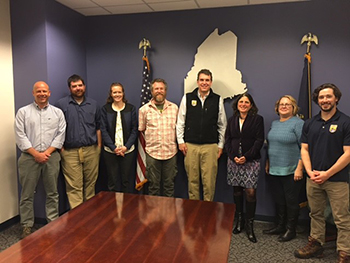
Photo of Atlantic salmon programmatic consultation team.
Courtesy of Eric Ham, MaineDOT
Data sources included:
- Final Endangered Status for a Distinct Population Segment of Anadromous Atlantic Salmon (Salmo salar) in the Gulf of Maine
- Status Review for Anadromous Atlantic Salmon in the United States (Fay et al. 2006)
- Draft Atlantic Salmon Habitat Recovery Plan
- Scientific literature
- Field investigations
- Existing MaineDOT practices
- Meetings and telephone conversations
Step 3 (Regional Ecosystem Framework)
During the development of the PBA, MaineDOT utilized species and critical habitat data compiled by NMFS for the 2009 final Atlantic salmon critical habitat designation. NMFS estimated the inland range of the Gulf of Maine population of Atlantic salmon and critical habitat and divided the population into three salmon habitat recovery units (SHRUs) (see figure below). MaineDOT also used information collected from the USFWS and Maine Department of Marine Resources through years of collaboration and project-specific coordination. Coordination with all partners allowed MaineDOT to better target recovery and production efforts under its mitigation program (see Steps 7-8).
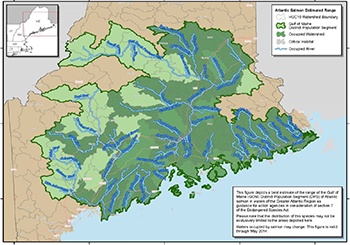
Atlantic salmon estimated range (as of May 2014) developed for use in section 7 Endangered Species Act consultations.
USFWS/NOAA
Step 4 (Assess Effects)
As part of the PBO, FHWA and MaineDOT, through close coordination with USFWS, conducted a complex analysis of effects of proposed transportation actions on Atlantic salmon survival and recovery and critical habitat. Eight general activity categories involving in-water work are covered by the programmatic consultation, such as bridge and culvert replacements, bridge scour countermeasures, culvert rehabilitations, and bridge maintenance. Primary effects include elevated turbidity/sediment transport, underwater noise, fish handling, and temporary habitat dewatering.
The PBA and PBO provide an estimate of the annual number of projects by activity category that will occur in areas with Atlantic salmon or its critical habitat. These numbers were compiled by looking at anticipated future projects, combined with experience on recent past projects.
Step 5 (Prioritize Actions)
In April 2015, FHWA, MaineDOT, USFWS, Maine Department of Marine Resources, and NMFS met to develop tiered priority areas based on species and habitat data and active recovery efforts (see Step 3). Maine salmon habitat recovery watersheds were grouped into three tiers:
- Tier 1: Highest value habitat and priority recovery efforts
- Tier 2: Priority watersheds where recovery efforts are not active, but which may contain populations important for recovery
- Tier 3: Areas with no documented Atlantic salmon or designated critical habitat
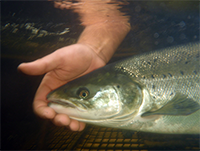
Photo of adult Atlantic salmon
USFWS/NOAA
The objective of the tiering was to prioritize fish passage facilitation, not necessarily to describe where Atlantic salmon and critical habitat occur. This effort resulted in development of maps, which were reviewed and approved by the agencies above and the four federally recognized tribes in Maine.
Step 6 (Crediting System)
To support development of an ecosystem crediting system, MaineDOT and its partners developed measurements of gains and losses of ecological functions associated with mitigation projects and established agreements for the use of offsite mitigation.
MaineDOT has been working closely with USACE and The Conversation Fund to develop an ILF program framework (see Step 8 below) and benefit-cost methodology. Atlantic salmon and its critical habitat (in terms of SHRUs) will be valued in relation to other environmental benefits and assigned a relative number of credits with an associated dollar amount.
Steps 7 and 8: Programmatic Consultation and In-Lieu Fee
MaineDOT’s activities have aligned particularly closely with Steps 7 and 8 of Eco-Logical.
Programmatic Biological Opinion
USFWS issued the PBO in January 2017. It addresses transportation activities that are funded by FHWA and/or permitted by USACE throughout the State of Maine. The PBO creates a streamlined approach to section 7 consultations by defining the effects of general activities that involve work in streams and are required for the construction, preservation, and/or maintenance of Maine’s transportation system. The project scopes range from larger projects, such as bridge and culvert replacements, to smaller projects such as scour countermeasures, culvert rehabilitations, and bridge maintenance.
The PBO outlines design standards and avoidance and minimization measures (AMMs) to implement during the planning and project development stages. Project sponsors submit a standard reporting form to USFWS containing relevant site-specific information, AMMs, potential take, and restoration benefits. To offset unavoidable adverse effects to habitat function, compensatory mitigation is required by either paying into an ILF program (see below) or through design and implementation of standalone mitigation projects.
The AMMs are mandatory and must be implemented by FHWA/USACE or MaineDOT/MTA and their contractors to meet the programmatic requirements. Terms and conditions stipulate that all applicable AMMs must be fully implemented and that FHWA and MaineDOT generate an annual report for USFWS regarding project timelines and monitoring.
Projects that occur in Tier 3 areas (see Step 5) result in “no effect” determinations. Projects in Tier 1 and Tier 2 areas are “not likely to adversely affect” (NLAA) or “likely to adversely affect” (LAA) Atlantic salmon or its critical habitat and are eligible for programmatic coverage. For a complete application package that qualifies for programmatic coverage, the following timelines apply:
- Informal consultations: 14 days (NLAA)
- Formal consultations: 30 days (LAA)
MaineDOT, in partnership with FHWA, USFWS and USACE, also developed a User’s Guide to streamline implementation and communication requirements of the programmatic consultation.
In-Lieu Fee Program
The Atlantic salmon ILF program will allow public and private applicants for Federal environmental permits to pay into an ILF mitigation fund instead of conducting project-specific mitigation. If the proponents elect to implement a mitigation project outside of the ILF, the projects will be designed to replace any lost habitat function at a minimum one-to-one ratio.
Permit applicants pay into the ILF fund based on the impacts attributed to their project. Mitigation fees are anticipated to range from $10,000 up to $200,000 on an individual project basis. MaineDOT estimates that up to $750,000 may be directed to mitigation funds annually under the PBO.
The ILF program is anticipated to be used primarily for projects in Tier 2 areas. Restoration, enhancement, and preservation projects will be selected based on their ability to compensate for impacts and provide ecological benefits for Atlantic salmon. An interagency review team will monitor ILF implementation and likely include members from USFWS, NMFS, the U.S. Environmental Protection Agency, USACE, and the Maine Department of Marine Resources.
The ILF program will provide an opportunity for recovery projects that previously lacked funding to apply to the fund and implement these important projects. Separate mitigation projects will also provide opportunities for expedited fish barrier removal in support of species recovery.
Key Results & Findings
Since 2013, collaboration and formal agreements and consultations among FHWA, MaineDOT, USFWS, USACE, and other partners are expected to result in the following key accomplishments with full implementation of the PBO and ILF program in summer 2017:
- Coverage for approximately 60 projects annually (75% of projects requiring consultation), compared to 7 projects annually in prior years.
- Doubling of the number of large culvert replacement projects and a substantial increase in the number of bridge replacement projects delivered annually.
- Annual direct cost savings of over $150,000 for MaineDOT from use of a project notification form in place of individuals BAs.
- Reduced USFWS consultation timeframes for MaineDOT projects requiring section 7 formal consultation from ca. 8 months to 1 month.
- Reduced consultation backlog for USFWS, allowing staff and transportation liaisons to focus on projects that do not fall under the PBO and thus require individual consultation.
- Increased consistency of mitigation efforts through the ILF program in line with Atlantic salmon restoration goals and substantially improved conservation outcomes for the Gulf of Maine Atlantic salmon population.
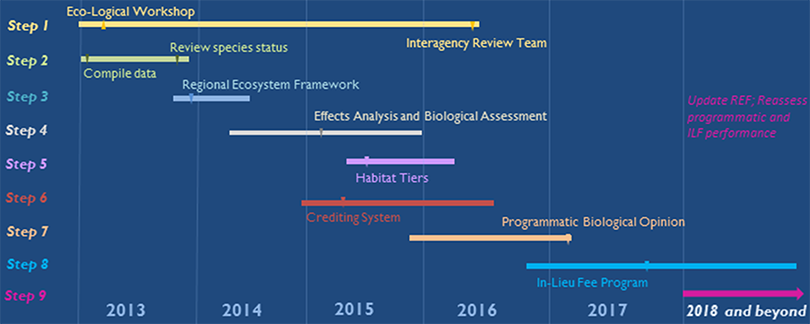
Timeline of MaineDOT’s Eco-Logical activities as part of the Atlantic salmon programmatic consultation effort
Lessons Learned
Key lessons learned from MaineDOT’s implementation of a landscape-scale approach include:
Importance of collaboration with partners.
Development of the programmatic consultation demanded collaboration between FHWA, MaineDOT, USACE, USFWS, and the MTA, which eventually resulted in increased trust. Since expectations were clearly outlined in the programmatic, conflict and disagreements were minimized. Interagency relationships have improved, such that face-to-face discussions about pending and current projects now occur regularly both in the office and out in the field.
Need for strong advocates.
MaineDOT, USFWS, and other agencies began the programmatic consultation effort with varying goals and expectations. Advocates for the programmatic approach at each agency were key to meeting milestones, especially when the group faced roadblocks.
Flexibility of in-lieu fee programs.
The Atlantic salmon compensatory mitigation program will be the first of its kind in Maine and will help ensure that unavoidable adverse effects are effectively offset. Implementation of the ILF program is expected to reach such a level that design changes become more cost efficient, resulting in a net gain for the species.
Benefits of a programmatic approach.
Programmatic approaches are examples of an abbreviated permit or consultation process. The Maine Atlantic Salmon Programmatic Consultation and other programmatic efforts focus on special area management plans and use species considerations to support or complement synchronized environmental and permitting reviews.
Next Steps
Annual program review.
FHWA, MaineDOT, USFWS, USACE and MTA will conduct annual program reviews and hold annual meetings. MaineDOT will develop annual reports, summarizing impacts to Atlantic salmon, number of projects, review timelines, monitoring information, and mitigation activities. These reports will be based on ongoing tracking of active projects using a system developed alongside the programmatic consultation.
Update programmatic and mitigation program.
MaineDOT and its partners plan to formally reassess the programmatic consultation and ILF performance after 5 years, as agreed to in the PBO (Step 9 of Eco-Logical). New data collection and analysis may be conducted.
Adaptive management.
MaineDOT will gauge the effectiveness of the programmatic approach on an ongoing basis, including costs associated with mitigation versus re-design. Opportunities to improve delivery via the PBO will be discussed with partners and implemented upon mutual agreement. This approach will capitalize on the efficiency and effectiveness of the PBO without waiting for an annual review.
For More Information
Contacts
Judy Gates
Maine Department of Transportation
Environmental Office
(207) 624-3097
Judy.Gates@maine.gov
David Williams
FHWA Office of Project Development and Environmental Review
(202) 366-4074
David.Williams@dot.gov
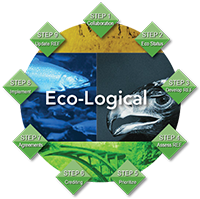
Resources

